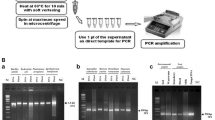Abstract
Conventional screening protocols for transgene integration in mice employ tail tips or blood samples as sources to obtain genomic DNA preparations. We have developed a simple alternative non-surgical method. Epithelial cells are scraped off the inner surface of the rectum with a sterile plastic inoculation loop and are lysed with Kawasaki buffer. The lysate can be directly examined in a polymerase chain reaction (PCR) analysis without any need for further DNA purification. This procedure causes minimal harm and stress to the animals and repeated samples can be obtained as often as necessary. This technique has been used successfully to identify transgenic mice from a number of different lines. The method allows quick screening of numerous animals and contributes to a reduction of the number of surgical biopsies required
Similar content being viewed by others
References
Attal, J., Cajero-Juarez, M. and Houdebine, L.M. (1995) A simple method of DNA extraction from whole tissues and blood using glass powder for detection of transgenic animals by PCR. Transgenic Res. 4, 149-50.
Blackburn, A., Schmitt, A., Schmidt, P., Wanke, R., Hermanns, W., Brem, G. and Wolf, E. (1997) Actions and interactions of growth hormone and insulin-like growth factor II: body and organ growth of transgenic mice. Transgenic Res. 6, 213-22.
Hogan, B., Beddington, R., Costantini, F. and Lacy, E. (1994) Manipulating the Mouse embryo: a Laboratory Manual. Cold Spring Harbor, NY: Cold Spring Harbor Laboratory Press.
Irwin, M.H., Moffatt, R.J. and Pinkert, C.A. (1996) Identification of transgenic mice by PCR analysis of saliva. Nature Biotechnol. 14, 1146-8.
Lahm, H., Amstad, P., Yilmaz, A., Borbenyi, Z., Wyniger, J., Fischer, J.R., Suardet, L., Givel, J.C. and Odartchenko, N. (1995) Interleukin 4 down-regulates expression of c-kit and autocrine stem cell factor in human colorectal carcinoma cells. Cell Growth & Diff. 6, 1111-8.
Maniatis, T., Fritsch, E.F. and Sambrook, J. (1989) Molecular Cloning: a Laboratory Manual. Cold Spring Harbor, NY: Cold Spring Harbor Laboratory Press.
Nadon, N.L. and Draeger, K. (1996) Genomic DNA analysis from mouse toe lysates. Transgenic Res. 5, 209-11.
Overbeek, P.A. (1994) DNA microinjection and transgenic animal production. In Pinkert, C.A. ed., Transgenic Animal Technology: a Laboratory Handbook. San Diego, CA: Academic Press. pp. 69-114.
Panaccio, M., Georgesz, M., Hollywell, C. and Lew, A. (1993) Direct PCR from solid tissues without DNA extraction. Nucl. Acids Res. 21, 4656.
Swolin, D., Brantsing, C., Matejka, G. and Ohlsson, C. (1996) Cortisol decreases IGF-I mRNA levels in human osteoblastlike cells. J. Endocrinol. 149, 397-403.
Wolf, E., Kramer, R., Blum W.F., Föll, J. and Brem, G. (1994) Consequences of postnatally elevated insulin-like growth factor-II in transgenic mice: endocrine changes and effects on body and organ growth. Endocrinology 135, 1877-86.
Author information
Authors and Affiliations
Rights and permissions
About this article
Cite this article
Lahm, H., Hoeflich, A., Rieger, N. et al. Identification of transgenic mice by direct PCR analysis of lysates of epithelial cells obtained from the inner surface of the rectum. Transgenic Res 7, 131–134 (1998). https://doi.org/10.1023/A:1008824509988
Issue Date:
DOI: https://doi.org/10.1023/A:1008824509988




